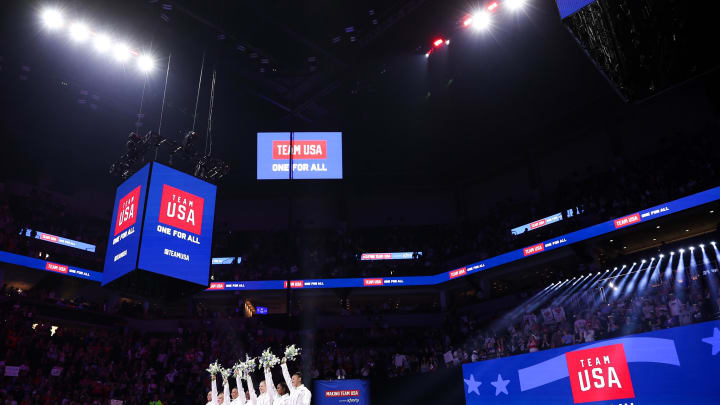U.S. Gymnastics Takes on Its First Olympic Opponent: Cardboard Beds

Check out Sports Illustrated’s Daily Rings, our daily Olympics podcast from Mitch Goldich and Dan Gartland. Subscribe wherever you get your podcasts (Apple, Spotify) and find clips on SI’s YouTube page.
Now that the U.S. women’s gymnastics team has made it through Thursday’s podium training—the practice event at which, three years ago, Simone Biles first began to show signs of the vertigo that would derail her Tokyo Olympics—they will all sleep easier.
Not just because Biles culminated the session with a breathtaking Yurchenko double pike vault, which suggests that the “twisties,” as the condition is known, is behind her. There’s also a more elementary reason.
“We’re getting mattress toppers today,” says coach Cécile Landi. “Hallelujah!”
The 13 athletes (five women’s artistic gymnasts, five men’s artistic gymnasts, two trampoline athletes and one rhythmic gymnast) arrived at the Olympic Village north of Paris on Monday. It took about 15 seconds for them to notice a problem: The mattresses felt like rocks.
“I sat on it and I was like, ‘Oh my God,’ ” says Landi with a laugh. “I was like, ‘Mary [McDaniel, who runs logistics]! Help!’”
Help was already on the way. A few days earlier, the team had announced a partnership with BedJet, which makes a cooling system that attaches to the bed and also offers mattress toppers and sheets that wick away sweat, but the technological problems that swept the world last week delayed the items’ arrival. The entire delegation expects to receive them Thursday.
Coach Jess Graba lights up at the possibility. “Are we getting any?” he asks. “I’m pretty sure the athletes will get those. I’m not sure I’m getting those. If I get one, I’ll be excited.”
The U.S. gymnastics team is just the latest squad to identify concerns about the accommodation at the Olympics, although many athletes admit it’s been better than what they feared when they first learned of France’s attempt to keep the enterprise as eco-friendly as possible by building beds from recycled cardboard and eschewing air conditioning. (Team USA immediately purchased portable air conditioning units and brought them to Paris.)
The U.S. women’s water polo team recently received mattress toppers as well and the Australian women’s water polo team ordered their own mattress toppers, too.
Many athletes have taken to social media to give tours of the furniture, with British diver Tom Daley bouncing on one bed and Irish rugby players Jordan Conroy and Harry McNulty flinging themselves onto another. So far, the cardboard seems to have held up.
And the athletes are thrilled to have a real village experience, after a Tokyo Olympics marred by isolation. The U.S. women’s gymnastics team stayed in a hotel in an attempt to mitigate the risks; this time around, they are enjoying even such details as the option to grab a snack. “They were sliding it under the door for us [in Tokyo],” Graba recalls.
Landi is a bit less effusive: “The food is what it is,” says Landi, who was born in Paris and grew up in Marseille. “It’s not the French cuisine I’m used to, but it’s not that bad.” But she concedes that she too is enjoying the village, having already been starstruck by encounters with Spanish tennis player Rafael Nadal and American swimmer Katie Ledecky.
Indeed, everyone seems more relaxed than they did three years ago. The U.S. women’s gymnastics team declined to speak to the media but left the arena smiling and joking with one another. It will face its first test Sunday, in the qualifying round of the team event. But first: a Friday rest day. Literally.
